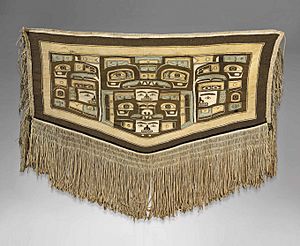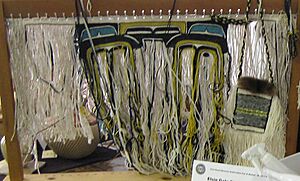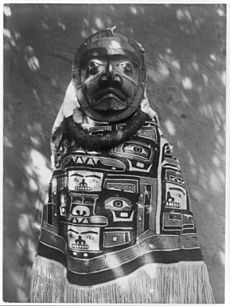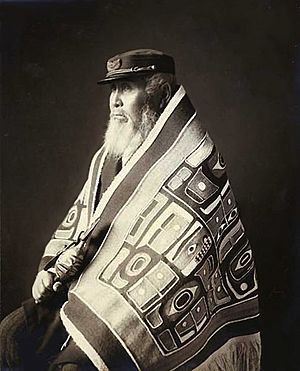Chilkat weaving facts for kids

Chilkat weaving is a special way of making cloth. It is a traditional art form of the Tlingit, Haida, and Tsimshian peoples. These groups are Native peoples who live in Alaska and British Columbia. Chilkat robes are fancy blankets. Important tribal members wear them for ceremonies and dances.
Contents
What is Chilkat Weaving?
The name "Chilkat" comes from the Tlingit people. They live near the Chilkat River in Alaska. Some Tlingit weavers believe the Nisga'a people first created this weaving style.
Chilkat weaving can be used for many items. These include blankets, robes, and dance tunics. It is also used for aprons, leggings, shirts, and hats. Chilkat clothing often has long wool fringes. These fringes sway when the person wearing them dances. Chiefs traditionally wore Chilkat robes during potlatch ceremonies. A potlatch is a special gathering for sharing and celebrating.
How Chilkat Weaving is Made
Chilkat weaving is one of the most difficult weaving styles in the world. It is unique because artists can weave curved and round shapes directly into the fabric. Making one Chilkat robe can take a whole year.
Traditionally, weavers used wool from mountain goats. They also used dog fur and bark from yellow cedar trees. Today, some weavers might use sheep wool instead.
The designs on Chilkat weavings are very special. They use a style called formline art. This art uses shapes like ovals, U-shapes, and S-shapes. These shapes create detailed pictures of clan symbols and animals. Often, you will see animal faces in the designs. Yellow and black are the main colors used. The natural color of the undyed wool is also common. Sometimes, blue is used as a secondary color.
The Looms used for Chilkat weaving are different. They only have a top bar and side supports. There is no bottom bar. This means the warp threads hang freely. Weavers work on small vertical sections at a time. They do not weave from one side to the other. Many designs are split into vertical columns. Like most Northwest Coast art, these columns are the same on both sides. This is called bilateral symmetry.
Bringing Chilkat Weaving Back

In the 1990s, only about six people still knew how to do true Chilkat weaving. But now, this art form is making a comeback!
A famous Chilkat weaver was Jennie Thlunaut (1891–1986). She was so good at formline design that she could create her own patterns. Thlunaut taught other weavers, like Anna Brown Ehlers and Clarissa Rizal. Rizal and others worked hard to teach new weavers. Because of their efforts, more people are now learning Chilkat weaving. This is happening in the Tlingit, Haida, and Tsimshian communities.
These tribes also create other types of weaving. These include Ravenstail weavings and button blankets.
See also



